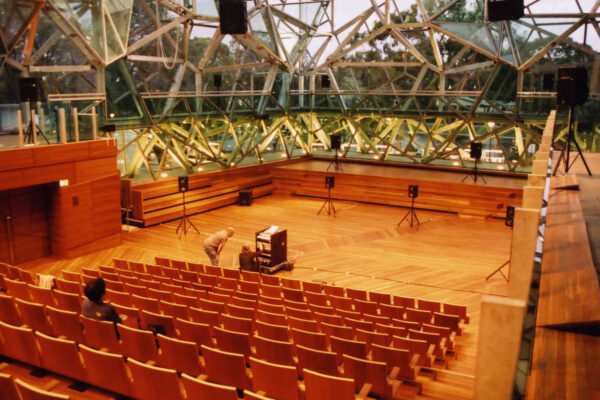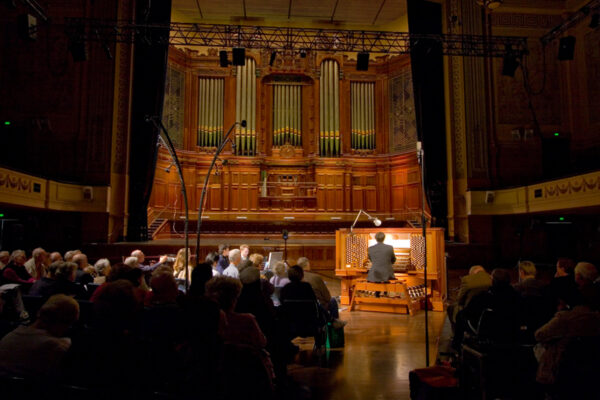Composing, performing and curating immersive sound experiences
The SIAL Sound Studios speaker orchestra uses up to 32 loudspeakers for electroacoustic music performances in small to large-scale venues. The system is scalable, portable and re-configurable. Each concert setting includes speakers above, around and when possible below the audience to create a theatre of sound, or cinema for the ears.
We design a unique spatial arrangement of loudspeakers for each event, taking into account the compositional details of each composition on the program, the acoustics and sound spatialisation opportunities of the venue, audience size and location, curatorial themes, or collaboration with individual performers or an ensemble. Each work is prepared in the studio along with other technical logistics. Rehearsals in the venue involve refinement of final spatialisation performance and mappings are adjusted to suit the space and speaker locations. This detailed spatial, technical and design approach means the practice has production requirements similar to choreography, theatre or lighting design – but focussed on advanced electroacoustic music composition.
Each concert is programmed and prepared from new compositions along with historical and contemporary works where sound and spatial composition are a key feature.
The SIAL Sound Studios system was established in the early 2000’s and remains the only operating speaker orchestra in Australia for presenting annual concert series, alongside teaching, research and development. Concerts are public and often in partnership with local arts organisations, performers, ensembles or festivals, For similar international systems, see the Aousmonium (INA/GRM Paris), BEAST (Birmingham University) and HYDRA (Harvard University), MOTUS (Paris), University of Greenwich, University of Bristol, MAAST (University of Kent).
The speaker orchestra is used by students in electives and design studios to present end of semester projects. Staff and post-graduate candidates undertake creative practice research through composition of new works that are developed and presented on the system in local concert series.
Brief history
Development of the SIAL Sound Studios’ speaker orchestra commenced during the startup phase of the studios in 2002-03. In the mid to late1990’s Lawrence Harvey had worked closely with Michael Hewes on two large concert series – The Reflective Space and the 1998 Next Wave Festival Sound and Contemporary Music Series. They developed speaker orchestras for each event using a combination of hired and sponsored equipment. In the 1998 event, guest artist Curtis Roads premiered Half-Life. Michael Hewes then developed the initial equipment specifications that started the RMIT system during 2002-03.
This early system was used for concerts in both the Australian Forum for Acoustic Ecology Conference (2002) and the Australian Computer Music Conference (2003). Technical direction of both events was by Tim Kreger. This early system was also used in a Liquid Architecture project supported by SIAL Sound Studios – speaker orchestra concerts by Daniel Turrugi and Bernard Parmegiani in Storey Hall, RMIT University in 2001. Reviewed in RealTime Arts here.
In the decade to 2012 we continued curatorial and technical development that supported more complex concerts. Developments included a Max/MSP patch for spatialisation, and the techniques used for CONSTRUCTION by Richard Barrett in the ARC Spatial Ensemble with ELISION Ensemble. In 2009 the system was used in 5 concerts programmed for the opening of the Melbourne Recital Centre, that included spatial works by Karlheinz Stockhausen, Iannis Xenakis, Luigi Nono, and other classics of the electroacoustic repertoire. The system has been adapted for exhibitions of the RMIT Sonic Arts Collection Sound Bites City (2013) and SITE and SOUND (2020-21). Throughout the 2010’s we added new speaker types and continued concerts on the system in RMIT University venues and local arts spaces. A full list of concerts appears here.

Photography: Christoph Ziegenhardt
2007 – Comparison of 3D modelled system design and partial system install for Opus ’09, Melbourne Recital Centre
2003 – AEFA Conference, Islands & Canopies
2007 – Auditory City Concert Series
2017 – Oceans. Photography: Vicki Jones
2011 – Construction, Huddersfield Town Hall, London
















